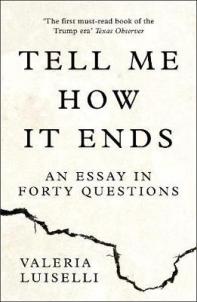The concept of Valeria Luiselli’s Tell Me How It Ends: An Essay in Forty Questions intrigued me. Luiselli, herself a Mexican living in New York, has aimed to look at immigration into the United States, and its effects on the many children who undergo a gruelling, and often unsuccessful, trafficking process each year. Tell Me How It Ends was originally written in English as a shorter essay, and lengthened when Luiselli decided to translate it into Spanish.
The book’s blurb states: ‘In this urgent, haunting, exquisitely written book, the questions  asked by Valeria Luiselli are her own, her children’s, and those she finds drawn up on the questionnaire drawn up by immigration attorneys for the tens of thousands of Central American children who arrive in the United States each year after being smuggled across Mexico to the US border.’ Luiselli herself worked as a voluntary interpreter in a New York immigration court, and thus has first hand experience of learning what the children whom she speaks to have already been through in their short lives. Her task is a relatively simple one; she follows what is written on the questionnaire, and translates the children’s stories from Spanish to English, to later present to the court dealing with individual immigration cases. She writes: ‘The children’s stories are always shuffled, stuttered, always shattered beyond the repair of a narrative order. The problem with trying to tell their story is that it has no beginning, no middle, and no end.’ In her introductory chapter, Luiselli informs us that ‘there are no answers, only more questions’ with an exploration of this kind.
asked by Valeria Luiselli are her own, her children’s, and those she finds drawn up on the questionnaire drawn up by immigration attorneys for the tens of thousands of Central American children who arrive in the United States each year after being smuggled across Mexico to the US border.’ Luiselli herself worked as a voluntary interpreter in a New York immigration court, and thus has first hand experience of learning what the children whom she speaks to have already been through in their short lives. Her task is a relatively simple one; she follows what is written on the questionnaire, and translates the children’s stories from Spanish to English, to later present to the court dealing with individual immigration cases. She writes: ‘The children’s stories are always shuffled, stuttered, always shattered beyond the repair of a narrative order. The problem with trying to tell their story is that it has no beginning, no middle, and no end.’ In her introductory chapter, Luiselli informs us that ‘there are no answers, only more questions’ with an exploration of this kind.
Interspersed with the stories of those whom she meets, Luiselli tells of her own experiences, as she and her family are deemed ‘non-residential aliens’ in the United States. They decide to apply for green cards, which, if granted, will make them US citizens. She discusses the process, which sounds draining by any form-filling standards, and its immediate aftermath: ‘When we finally sent out our applications… we started feeling strange, somewhat out of place, a little circumspect – as if throwing that envelope in the blue mailbox on our street corner had changed something in us.’ They decide to set off on a roadtrip soon afterwards, and their journey soon converges with the refugee crisis reaching its peak: ‘We start hunting down any available information about the undocumented children and the situation at the border, we collect local newspapers, which pile on the floor of our car, in front of my copilot seat. We do constant, quick online searches and tune in to the radio every time we can catch a signal.’
The structure within Tell Me How It Ends is fitting. Luiselli has approached her central question – what will happen to immigrant children when they reach the United States? – by focusing on forty separate, but interrelated questions or points. Each of these questions forms the immigration questionnaire.
Luiselli’s account and exploration is a measured one. Throughout, she talks of opinions expressed by different groups inside America, some of whom deem the refugee crisis ‘a biblical plague’, going on to mock how ridiculous their view of innocent children as a widespread threat to their way of life is: ‘Beware the locusts! They will cover the face of the ground so that it cannot be seen – those menacing, coffee-coloured boys and girls, with their obsidian hair and slant eyes. They will fall from the skies, on our cars, on our green lawns, on our heads, on our schools, on our Sundays’. She balances this with those who welcome the children with open arms, going out of their way to help their plight.
Some of the facts which Luiselli presents are shocking; for instance, ‘eighty percent of the women and girls who cross Mexico to get to the U.S. border are raped on the way’, and that during six months of 2010, there were more than 11,000 abductions during the journey. Between April 2014 and August 2015, she tells us, ‘more than 102,000 unaccompanied children had been detained at the border’, which demonstrates starkly how widespread this problem is. Throughout, Luiselli recognises the individuality of each child, and each case: ‘Each child comes from a different place, a separate life, a distinct set of experiences, but their stories usually follow the same predictable, fucked-up plot.’
Tell Me How It Ends is topical and important; a really moving and meaningful piece of reportage. It demonstrates just how widespread the plight of many Central Americans is, and how they are willing to risk almost everything to find what they perceive will be a better life in the United States. Luiselli’s account is poignant and searching, and as lucid as it is contemplative. Her position as interpreter gives her voice authority, as does the way in which she approaches the issue of immigration. She is highly, wholly empathetic to every child whom she meets, and everything which she presents is sensitively wrought. There is an awful lot of depth within Tell Me How It Ends, and it is both a thought-provoking and unsettling read.
I shall end this review with rather a fitting quote from Luiselli, after many of the cases which she writes about have been explored: ‘In the meantime, while the story continues, the only thing to do is tell it over and over again as it develops, bifurcates, knots around itself. And it must be told, because before anything can be understood, it has to be narrated many times, in many different words and from many different angles, by many different minds.’
Purchase from The Book Depository
Advertisements Share this:





